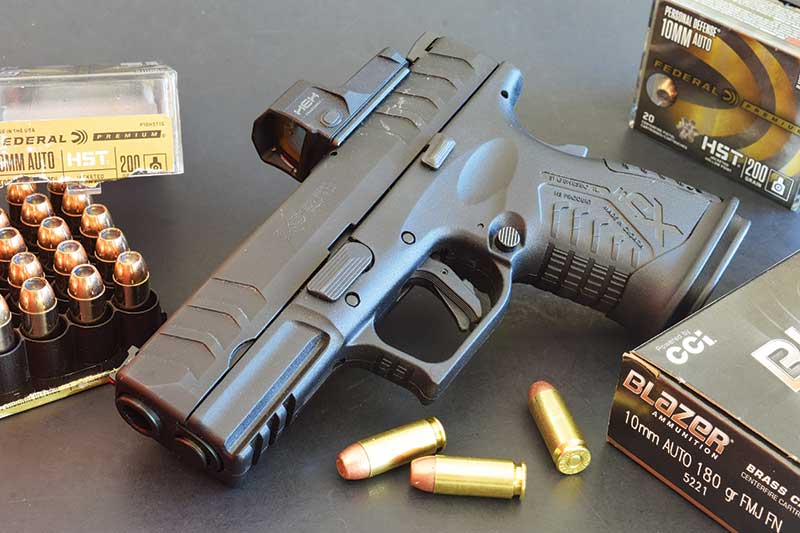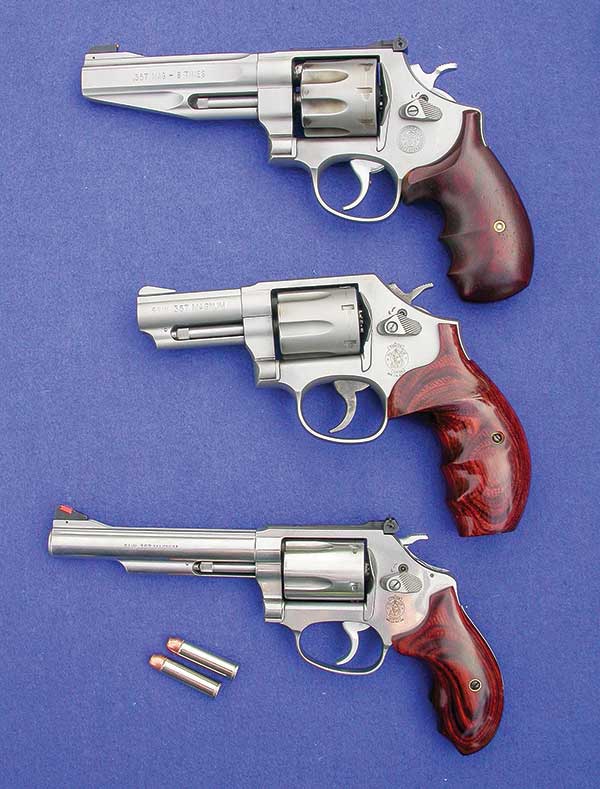Bear Guns For Elk Country
Protecting Yourself Against The Alpha Predator
The weather was turning when Two Pony and his partner set out to retrieve strays from a remote canyon. They got most of the animals headed downcountry before the storm broke. Camping that night, they readied their snowshoes to finish the search. Tracks the next morning led to a carcass. A fresh one.
The grizzly came fast and silent. Two Pony yelled. His .38-40 popped hollowly twice; then the cowpuncher was dead. His companion lunged for the revolver, then staggered under the blow of a great claw that shredded his face. He tasted blood. He smelled the bear’s foul breath. Later he would learn he had pulled the trigger — his bullet had entered the bear’s chin and driven up into the brain.
Yesterday and Today
A century ago, when Two Pony fell, cattlemen gave no quarter to the beasts that had intimidated Lewis and Clark. But protection stabilized their numbers. In the last 50 years, grizzlies have increased. Nowhere in the lower 48 is it lawful to kill them but each fall, elk hunters in the northern Rockies swarm their habitat. Hunter-grizzly encounters have become more common — and often end badly for both.
A couple of years ago, a guide from our Wyoming camp barely had time to fire in front of a bear charging his clients. Turning in mid-stride, the beast dashed past the men. Another hunter, returning to an elk he’d shot the previous evening, found a grizzly had eaten much of it. Bear traffic in that area was so heavy, paw prints on main trails had erased the tracks of pack stock. Meanwhile, a Montana hunter was mauled and his guide killed by a grizzly that showed up where they were field-dressing an elk.
For decades, outfitter Ron Dube hosted hunters in elk camps east of Yellowstone. He never had to shoot a bear. “I stayed alert, kept my head and didn’t show fear. One grizzly followed his nose to my pan as I fried supper at a spike camp. Loudly, I threatened violence if he didn’t leave. He did.” Dube told me he was truly alarmed only once. “A client and I came upon a big griz on a carcass. He was unaware of us, but paced about the kill, growling and bristling, asserting ownership. A dangerous bear. We backed off.”
Avoiding bears is the best way to prevent bloodshed. Failing this, a bluff can discourage a bear but “making big” as if you itched for a fight might also get you one. Running can trigger a predator-prey response. Bears sprint at 40 mph.
Once, on a Montana hunt where we saw grizzly tracks every day, I descended in deep snow for a mid-day rest below a slide. Shedding my pack under a solitary pine, I spied an elk carcass in nearby timber. As if on cue, snow on the slope above burst in a backlit cloud. A magnificent grizzly, silver coat rippling, catapulted downhill in clouds of sparkling powder. He passed me and skidded to a halt at the elk.
I hugged the pine. The bear began batting the skull about. It bounced my way. He followed, into a breeze that carried my scent. I held my breath. At 19 yards he stiffened. Tense seconds later, he loped into the conifers. I grabbed my pack, put the pine between us and strode quickly away around the elk. His elk.
Rifles And Bear Spray
A carcass is a bear magnet. A grizzly may be watching it — or the mound of earth and leaves that buried it — from nearby cover. On the trail of game you’ve shot, move slowly, talk loudly. In bear country you’re smart to carry bear spray. Well directed, it is usually effective, sparing you and the bear.
Alas, I find bear spray awkward to aim and not as quick to deploy as, say, a handgun.
How about a rifle? It’s easier to aim and more powerful. Yes, but many hunters carry bows and muzzle-loaders. And a bear is quick. If it gets to you, it can flip a rifle off-target or tear it from your hands. In the autumn of 1988 as L.W. Jones eased through Alaskan alders, a grizzly burst upon him so fast it slapped his rifle aside before he could fire.
Jones recovered and managed to jam the muzzle into the bear’s mouth. The animal wrenched it away and beat Jones to his shoulder holster, which tore and spilled his .44 Magnum. Then the beast clamped canines into the man’s shoulder, picked him up, shook him and threw him down. It mauled his head then snatched him up by the thigh. Dashed to earth again, Jones felt great claws rip into his stomach…. Somehow, he lay still. When he no longer heard the bear breathing, he struggled to camp. His friends, quick transport and four hours of surgery saved him.
Handgun Choices
The .38-40 (.38 WCF) was first offered in Winchester’s 1873 rifle, a year after its debut in .44-40. In 1886 the .38-40 joined the .44-40 and .45 Colt in Colt’s Single Action Army revolver. Between 1873 and 1941, these three cartridges would account for 80% of SAAs sold. A potent cartridge in Two Pony’s day, the .38-40 fired a 180-grain .401 (not a .38!) bullet at about 850 fps.
In modern firearms, the .38-40 can be loaded to match the punch of the .40 S&W! However, by the 1960s it had been upstaged by the .357 Magnum and, to a lesser extent, Herter’s .401 Powermag offered by J.P. Sauer & Sohn in SAA clones. Elmer Keith had shepherded the .44 Magnum; Dick Casull had added muscle to.45s.
In the field, as in an emergency at home or on the street, a handgun is useful only if it’s with you and quick to hand. After a couple of days on the mountain, a heavy, bulky revolver is easy to leave in camp. Mid-size revolvers and autos make more sense — in holsters you can access fast from awkward positions.
An elk guide I know prefers his .357 with heavy hard-cast bullets. SA or DA, a .357 revolver can be made slimmer and lighter than a .44 Magnum. While big-bores have the clear edge in power, bullets of high sectional density from stiff .357 loads hit hard and bite deep. In auto pistols, the 10mm is more than a match, its 180- and 200-grain bullets packing over 600 ft-lbs. Buffalo Bore lists a 180-grain JHP at 1,350 FPS for 728 ft-lbs., also a 220-grain hard-cast at 1,200 FPS for 703 ft-lbs. This 10mm load is shared by Grizzly Cartridge, which also sells a 200-grain flat-nose at 1,250 FPS. Muzzle-energy: a “mere” 694 ft-lbs! Underwood wrings 676 ft-lbs. from a 150-grain solid at 1,425 FPS. Black Hills has a 10mm HoneyBadger load, the 115-grain fluted bullet exiting at 1,664 FPS with 695 ft-lbs.
The only round to challenge the 10mm in standard-size auto pistols is the .400 Corbon, developed in 1995 by Peter Pi on a necked .45 hull. It kicks 165-grain bullets at 1,300 FPS, for 619 ft-lbs. While the .400 Corbon is only commercially chambered in a few pistols, the 10mm appears in countless 1911 platforms and other autos from SIG, GLOCK and Springfield — even revolvers!
Auto pistols hold more rounds than do revolvers and they pack flat. With factory loads, high-quality autos are now utterly reliable. Alloy frames trim weight; cycling takes the sting out of recoil. Plus, autos are more red dot-friendly. Springfield’s XD-M Elite, with a 3.8″ barrel and Hex Firefly red dot sight delivers big-beast punch from a package comfy to carry, quick to point and easy to shoot accurately.
Rigs
How you carry a pistol can determine the outcome of a bear encounter.
Unlike a hunting handgun, secured in a holster until deliberately drawn, a back-up pistol must yield instantly to a one-hand draw from any position. Not just Weaver or isosceles stances, but scrambling over a deadfall or with your back to Mother Earth or going fetal! Still, it is best kept out of the weather and it mustn’t spill accidentally.
In my view the best place for a back-up pistol (or bear spray) is on your chest. Hunting coats that overhang a gun in a belt holster can impede a draw, especially if you’re flat on the ground. Reaching for a gun on your belt, or in a shoulder holster, also involves much hand and coat motion. Opening your coat to access a chest holster is quicker, less obtrusive. If you get knocked down, your hands naturally come up close to your chest to shield your vitals. You can reach a chest holster face-down or face-up.
If you spot a bear close by and it’s too late to slip away undetected, staying still makes sense, at least for the moment. Easing your hand slowly to a pistol’s butt in a chest holster shouldn’t change your profile or your position. Want to pull off a mitten in cold weather? Your teeth are inches above the gun.
My favorite rig for a back-up pistol — and for a hunting handgun — is Galco’s Great Alaskan chest holster. Intelligently designed and beautifully made, it’s offered for pistols and revolvers with pouches for magazines and loose ammo. I use one for 1911s. Another carries my 4 ⅝” Ruger Blackhawk .45. An alternative, of similar design and quality, is the Falco (yes, that spelling is correct).
For belt carry of my S&W 66, I’ve long used a Milt Sparks holster. But Galco’s Combat Master, of double-stitched steerhide, better secures this .357. It shields the guard and trigger as well as the barrel, frame and cylinder. Butt-forward cant puts the pistol where my hand catches it naturally in a firing grip.
The brimstone you release with a trigger pull is for naught unless your holster brings your gun to hand before you smell bear breath.















